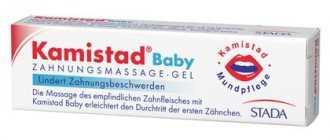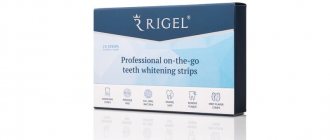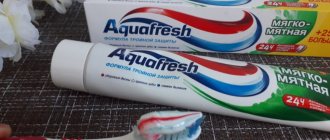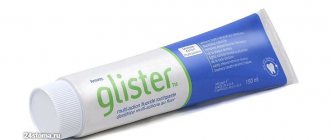1933
Pulposeptin is a dental paste for the treatment of bacterial root canal infections.
The drug is produced on the basis of antibiotics with bacteriostatic and bactericidal action, it stops the growth and reproduction of pathogenic microflora, and destroys some species. The paste is used in pediatric and adult dentistry.
Composition and properties of the product
The main active ingredients in the drug:
- Chloramphenicol is a broad-spectrum antibiotic, active against staphylococci, streptococci, Neisseria, Klebsiella, as well as those flora that are resistant to penicillin, sulfonamides, streptomycin.
- Neomycin sulfate - used exclusively topically (due to its high toxic effect on the kidneys and liver), has a bactericidal effect on cocci, protozoa, and bacilli.
- Dexamethasone is a synthetic steroid hormone that has an anti-inflammatory effect. Relieves swelling, allergic manifestations, reduces the level of intoxication.
- Polyethylene glycol is an excipient, solvent, emollient component in ointments and pastes.
- 2-phenoxyethanol is a preservative.
A balanced formula of antibiotics with a wide range of antimicrobial action quickly and effectively suppresses infection in the pulp (the loose structure that fills the tooth cavity).
The active substances do not enter the systemic bloodstream, do not have a negative effect on the functioning of internal organs, and are not addictive.
The hormone included in the composition blocks the progression of the acute inflammatory process in the periapical tissues - the soft structures surrounding the apex of the tooth root, the alveolar bone.
How does chronic fibrous pulpitis manifest itself and methods of its treatment.
Come here to learn more about the symptoms of diffuse pulpitis.
At this address https://www.vash-dentist.ru/lechenie/zubyi/pulpit/pri-gipertroficheskom.html we will talk about the differences between hypertrophic pulpitis and other types of pathology.
In what cases is pain in a pulpless tooth dangerous?
DentoSpas Clinic recommends contacting your doctor again if the following symptoms appear:
- the pain becomes sharp, throbbing, intensifies, does not weaken, and may be more pronounced at night;
- painkillers prescribed by the doctor do not work or relieve pain only slightly;
- there is sensitivity, discomfort when contacting cold;
- the patient has a fever and other symptoms of illness: weakness, headache;
- the gums become very swollen and inflamed;
- discomfort persists for a long time or returns some time after treatment (the tooth begins to hurt again).
These signs indicate complications of endodontic treatment. Pain may have several causes.
Reappearance of infection. Occurs if the infected tissue was not completely removed during the initial treatment. A source of infection remained inside the crown, under the filling, and tissue destruction continued.
Errors during filling. If the root canals are not filled tightly or completely, the voids remaining inside them threaten the re-development of infection. Microbes penetrate into them through surrounding tissues, causing inflammation. The pain comes from him. Another possible mistake is that the canals are not filled with filling material to the full depth. To exclude it, the DentoSpas clinic performs control radiography and uses an apex locator to assess the depth of the canals. There should be no voids left at the root apex after filling - this is dangerous due to the formation of granulomas and cysts, and destruction of hard tissues.
The filling material has gone beyond the root tip. This occurs if it is squeezed out through the apical foramen. Dental cement in this case hardens in the periodontal tissues, squeezing the nerves and impairing blood circulation. Because of this, inflammation begins and severe pain appears.
Perforation of the root walls. When cleaning root canals, the root walls may be perforated with an endodontic instrument. At the site of the hole, the tissue becomes infected and inflamed. When filling, perforation is dangerous due to the filling material leaving the root canal.
A fragment of the instrument remains inside the channel. This is a rare mistake. Such debris is clearly visible on control X-ray photographs. If they still remain inside the canal, it becomes clogged, making it more difficult to treat. Because of this, infected tissue remains at the root tip, which provokes re-inflammation.
Complications can arise not only due to treatment errors:
- allergy. Individual sensitivity to the components of the filling material or the medications used, their intolerance can provoke the appearance of pain, swelling, and discomfort immediately after treatment. Such symptoms do not go away on their own, they gradually intensify, and severe inflammation begins;
- damage to the adjacent tooth. The pain in it can spread along the gums and radiate into the pulpless tooth;
- trigeminal nerve injury. It occurs if it passes next to a pulpless tooth and was touched during its treatment. In this case, the pain is shooting, may be accompanied by numbness, and spread throughout the jaw.
Indications
Pulposeptin is used in endodontics to eliminate the source of infection. Medicinal dressing of root canals (paste injection) is done for the following pathological conditions:
- Periapical periodontitis is an infectious or traumatic inflammation of the periodontium with a violation of the integrity of the ligaments (secure the tooth in the alveolus), internal and external alveolar processes (cortical plate).
- Periapical abscess is a local limited accumulation of pus on the surface of the alveolar process (externally or internally). It develops against the background of advanced caries, periodontal diseases, and chipped teeth.
- Periapical granuloma is a clearly limited inflammation of an infectious nature, proliferation of soft tissues with the formation of nodules (granulomas).
- Gangrenous pulpitis is purulent inflammation of the neurovascular bundle of the tooth, followed by tissue death.
- A fistula is a canal from the root of a tooth through the jawbone, which is formed during the disintegration of an inflammatory focus for the release of pus. After the inflammation has stopped, the wound heals and heals.
- Odontogenic radicular cysts – arising in a chronic inflammatory focus of periodontal tissues. The neoplasm is located at the apex of the tooth root. An inflammatory infiltrate and hemorrhages are found in the cavity.
Pulposeptin paste is also used for prophylactic purposes to prevent the proliferation of pathogenic flora after endodontic manipulations (removal of canal contents, preparation for the filling stage).
Indications for use
"PULPOSEPTIN" is used as a medicinal dressing for root canals in the treatment of periapical periodontitis, gangrenous pulp, and acute inflammation.
In addition, the drug is used to treat fistulas, granulomas and cysts. "PULPOSEPTIN" has a wide range of bacteriostatic effects.
With the help of dexamethasone, acute allergic, inflammatory and painful processes are blocked in the periapical tissue.
Neomycin sulfate has an effect on most bacteria resistant to chloramphenicol. It is characterized by a wide spectrum of antimicrobial action. It is active against many gram-negative bacteria and cocci.
Chloramphenicol is characterized by a wide spectrum of antimicrobial action and activity against many types of microbes. It has an effect on strains of bacteria resistant to streptomycin, penicillin and sulfonamides.
Instructions for use
Before applying the paste, the root canal is thoroughly prepared. For endodontic treatment, EDTA (acid) is used to expand the canal and improve the permeability of Puloseptin into the walls.
The treatment is carried out several times alternately with sodium hypochlorite (disinfector, antiseptic irrigation solution). After completing the preparatory procedure, the dental canal is dried.
The paste is injected to the apex (the very apex of the root) using a canal filler - an endodontic instrument in the form of a conical spiral, a helical rod with a tail for rotation. The resource of one filler is 3 cycles of filling one channel.
After filling with paste, the canal is closed with a sealed bandage (temporary filling) made of indifferent material (which does not affect the surrounding tissue). This allows you to quickly restore the anatomical shape of the crown. The temporary filling can be easily removed.
The required dose of Pulposeptin paste is determined individually. The maximum amount for filling a root canal in an adult patient is 20 mg.
The duration of the treatment course is 5-7 days. This time is enough to destroy the infection, relieve swelling, reduce inflammation, and stop an allergic reaction.
On a second visit, the dentist removes the filling material and any remaining drug. Cleans and carries out antiseptic treatment of the canal, thoroughly dries the cavity.
Then the root is filled with filling material (two-component paste based on epoxy resins, radiopaque material based on zinc oxide and eugenol).
Attention! Pulposeptin paste is intended exclusively for professional use in dental offices. Self-treatment of purulent inflammation of the oral cavity at home is unacceptable.
Signs of chronic gangrenous pulpitis and treatment of pathology.
In this article you will find instructions for using Pulpotec in pediatric practice.
Here https://www.vash-dentist.ru/lechenie/zubyi/pulpit/slozhnosti-vyiyavleniya-nachalnogo.html all the most important things about initial reversible pulpitis.
Application diagram
During temporary filling of dental canals, a non-hardening plastic paste can be placed in the root cavity for various periods of time.
The length of time the drug remains in the root can vary from three days to several months. After a certain time, when the desired result is achieved, the paste is removed from the canal.
Before filling the canal with paste, it must be prepared. To achieve this, the following activities are carried out:
- endodontic treatment of the canal cavity is carried out up to the apex;
- for processing, materials containing EDTA are used (gel or liquid that expands the canal cavity);
- sodium hypochlorite is also used, which is used for treatment, alternating with EDTA agents;
- at the end of treatment, the canal is thoroughly dried with a special agent;
- Pulposeptin is injected into the prepared cavity up to the apex, for this a special instrument is used - a channel filler;
- the paste is covered with a temporary bandage.
Each individual case of treatment requires an individual dosage of the drug. For one canal opening, the full dose is considered to be 20 mg of the drug. In the apex area, a small amount of paste has a therapeutic effect. Most of it is located in the root canal. Therefore, systemic effects are completely excluded.
A repeat visit to the dentist is scheduled after five to seven days. During this visit, the temporary covering bandage is removed along with any remaining material.
The channel is thoroughly cleaned and treated with all necessary materials. The last step is to dry the canal and then fill it with filling material.
Warnings
Subject to storage conditions and proper transportation, the drug does not cause side effects.
In rare cases, symptoms of a local allergic reaction can be observed in people with high sensitivity to antibiotics:
- burning, irritation of the gums in the area of the diseased tooth;
- pathological swelling of the oral mucosa and tongue;
- local increase in temperature, hyperemia of soft tissues;
- rashes, both on the mucous membrane and on the outside of the skin in the area of the nasolabial triangle.
There are no contraindications to the use of the drug; no incompatibility with other drugs has been identified.
Pulposeptin does not penetrate the hematogenous (blood) and placental barrier. Does not have a teratogenic effect on the fetus (does not disrupt embryonic development through toxic effects). Therefore, the paste can be used in the treatment of pregnant women in any trimester.
The drug does not pass into breast milk and does not affect the physical and mental development of the baby. Pulposetin is harmless for nursing mothers.
special instructions
The use of the product does not affect the ability to drive a car.
The use of the drug during pregnancy is allowed after consultation with a doctor. Treatment of pulpitis during pregnancy is carried out using a minimal amount of paste to eliminate infection and relieve pain. Major treatment is delayed until after the baby is born.
Treatment with Pulposeptin during lactation is allowed. The drug contains a low concentration of medicinal substances that cannot adversely affect the human body.
Accordingly, these substances pass into breast milk in even smaller quantities, so there is no need to fear for the baby’s health. In rare cases, allergic reactions may occur in the form of rashes and redness, which do not pose a danger to the child’s body.
The bitter taste of the medicine may be noticeable due to the fact that the drug mixes with saliva, affecting the taste buds.
Release form, price, analogues
The drug for topical use is available in the form of a paste of dense consistency in aluminum tubes with a volume of 10 g. The medicine can be stored in the refrigerator at a temperature of at least 4°C or at room temperature up to 20°C.
Important! At higher temperatures, the paste separates, making it unsuitable for use for medicinal purposes.
Before use, to ensure the plasticity of the material, the preparation can be slightly warmed up. It is enough to hold the tube in your clenched palm for no more than half a minute.
The cost of Pulposeptin in online pharmacies varies from 940 to 1146 rubles. for one unit of goods. Manufacturer – Russia.
Antiseptic analogues for filling root canals (therapy of pulpitis, periodontitis):
- Yodent (iodoform paste) - available in a 25 g darkened glass bottle. Manufacturer - Russia.
Cost – 162 rubles. Non-hardening paste is used for acute and chronic periodontitis. The main active ingredient is chlorophenol, iodoform. A side effect is pain during the first 1-2 days after filling the canal with paste. - Abscess Remedy - creson-based paste (disinfector) with dexamethasone. Available in plastic or glass jars. Manufacturer – Switzerland. Price – 2150 rub. Indicated for pulpitis, purulent periodontitis, abscesses.
- Tempofor is a paste based on creosote, thymol, camphor, and iodoform. Manufacturer – France. Cost – 1980 rubles. Indications: treatment of pulpitis, periodontitis, baby teeth in children, including those with absorbable roots.
- Septomixin is a broad-spectrum antiseptic paste with dexamethasone.
Active ingredients: neomycin sulfate, polymyxin sulfate, tyrothricin. Available in 7.5 g tubes. Manufacturer: France. Price – 4988 rub. It is used to treat severe forms of periodontitis that occur with complications. - Ledermix is a paste based on demeclocycline and triamcinolone (synthetic hormone). Produced in aluminum tubes of 5 g. Manufacturer – Germany. Cost −4500 rub. Indications: treatment of gangrene, acute periodontitis, pulpitis.
- Grinazol is a drug based on metronidazole for the treatment of gangrenous pulpitis. Tube volume – 4.5 g. Manufacturer – France. Price – 4230 rub.
Indications for use and purposes of use
As mentioned above, the paste is used for inflammatory processes, periodontitis, gangrenous pulpitis, tooth and gum cysts.
The drug is placed into the inflamed cavity for the following purposes:
- to eliminate severe pain;
- to destroy pathogenic microflora of the root canal and dentinal tissue;
- to reduce the inflammatory process of periodontium;
- to stimulate regenerative processes in bone tissue.
What you need to know about pulpitis, its symptoms and treatment:
Reviews
If you have had root canals treated with Pulposeptin, please share your experience using this remedy. Tell us if you had any complications, how quickly the infection and symptoms such as toothache, inflammation, swelling resolved, and how quickly you returned to your normal eating regimen.
If you find an error, please select a piece of text and press Ctrl+Enter.
Tags pulpitis
Did you like the article? stay tuned
Previous article
Purpose of the Coffin spring in orthodontic appliances
Next article
Impression of teeth during treatment with braces, why can’t you do without it?









